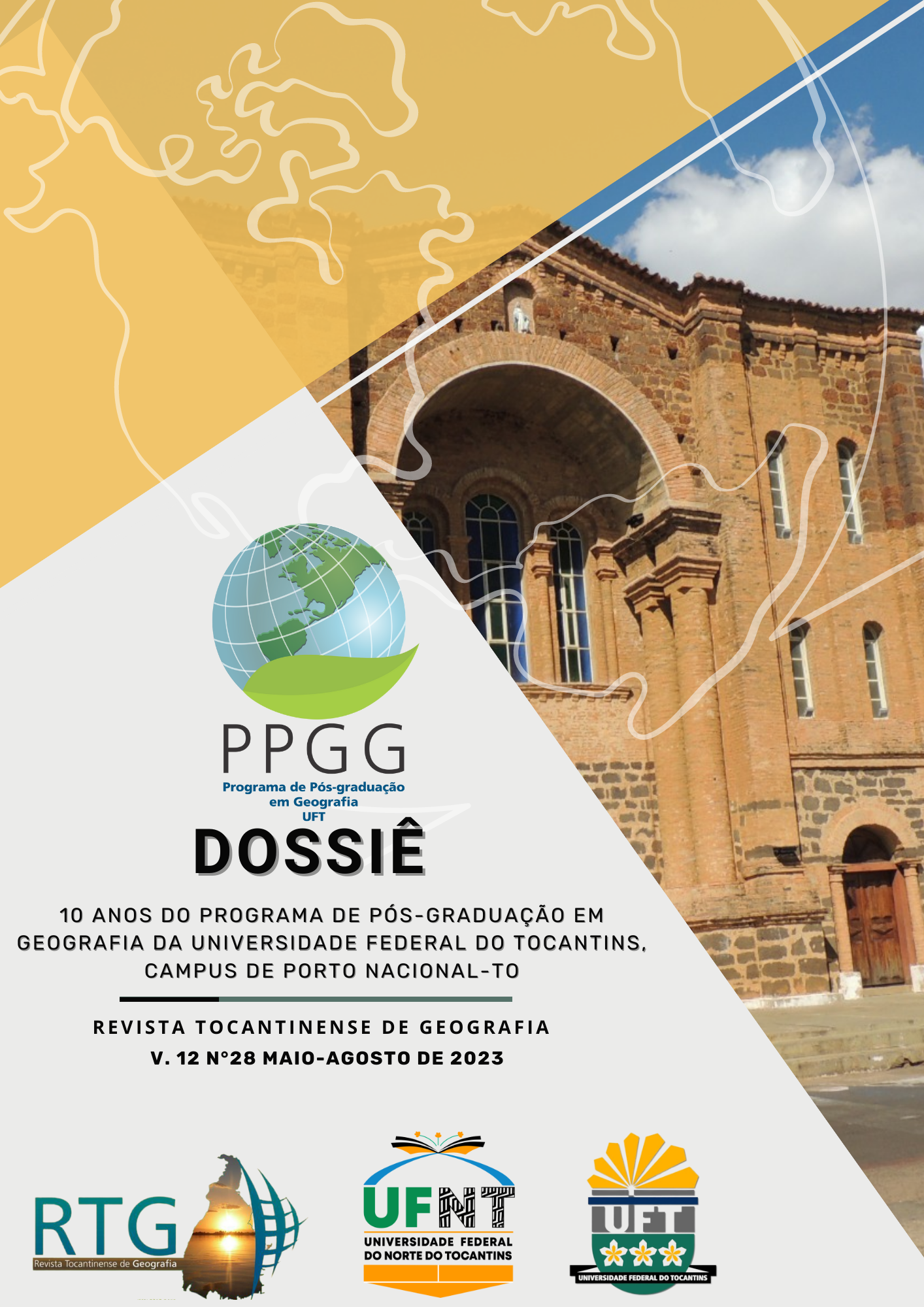THE URBAN PRESSURE IN THE SURROUNDINGS OF THE FAZENDINHA'S ENVIRONMENTAL PROTECTION AREA IN MACAPÁ-AMAPÁ
DOI:
https://doi.org/10.20873/rtg.v12i28.16682Keywords:
Territory, Conservation units, CitiesAbstract
In Amapá, land use is presented from different perspectives. The environmental bias is one of these scenarios, which echoes in contemporary society, as an urgent discourse of planetary survival. The population and urban dynamics perceived in Amapá, especially in the cities of Macapá and Santana, reveal an urban production based on meeting the advance of productive activities, in particular in the use of urban land, a condition that reverberates in the surroundings of the Fazendinha Environmental Protection Area . The objective of this article is to contribute with an analysis of how the capitalist production of the territory has advanced and provoked an urban pressure in the vicinity of the APA da Fazendinha, impacting its existence and maintenance. This work is part of the master's thesis defended in December 2022 by the Graduate Program in Geography at the Federal University of Amapá - PPGEO/UNIFAP. This analysis focused on theoretical discussions, field activities and map production. The reflections and meditations listed here allowed confirming that the urban pressure exerted around the APA is a reflection of the urbanization process through which the referred cities experience and that the environmental preservation built in the implementation of the conservation units is, in fact, a geopolitics government, assuring to the State the domain and control of portions of the territory.
References
AMAPÁ (Estado). Secretaria de Estado do Meio Ambiente - SEMA. Áreas protegidas do Estado do Amapá. Coordenação Geoprocessamento e Tecnologia da Informação Ambiental – CGTIA: Macapá, 2012.
AMAPÁ (Estado). Lei nº 0873 de 31 de dezembro de 2004. Dispõe sobre a Criação da Área de Proteção Ambiental da Fazendinha, no Município de Macapá. Macapá, 2004.
AMAPÁ (Estado). Secretaria de Estado do Meio Ambiente - SEMA. Relatório Técnico: Coletânea de Informações Sobre a APA da Fazendinha. Macapá, AP, 2009.
AMAPÁ (Estado). Decreto Territorial nº 030 de 24 de outubro de 1974. Dispõe sobre a Criação do Parque Florestal de Macapá. Macapá, 1974.
ARAÚJO, Marcos Antônio Reis. Unidades de Conservação do Brasil: A História de Um Povo em Busca do Desenvolvimento e da Proteção da Natureza. Organizado por NEXUCS – São Carlos: RiMa Editora, 2012.
ÁREAS PROTEGIDAS. Fundo Vale. In MILANO, Miguel Serediuk. et al. Conceitos, Histórico, Políticas e Formas de Gestão. 1. ed. – Rio de Janeiro: Fundo Vale, 2012.
BRASIL. Lei nº 9.985, de 18 de julho de 2000. Regulamenta o art. 225, § 1º, incisos I, II, III, e VII da Constituição Federal, institui o Sistema Nacional de Unidades de Conservação da Natureza e dá outras providências. Brasília, DF, julho de 2000.
BRASIL, Ministério do Meio Ambiente, Cadastro Nacional de Unidades de Conservação. Brasília, 2022. Disponível em: http://sistemas.mma.gov.br/portalcnuc/rel/index.php?fuseaction=portal.consultarFicha
BECKER. Bertha K. Modelos e cenários para a Amazônia: o papel da ciência. Revisão das políticas de ocupação da Amazônia: é possível identificar modelos para projetar cenários? Parcerias Estratégicas - Número 12 - Setembro 2001.
BELEZA, Elismar Morais; FILHO, Juraci Ribeiro Dias; LIMA, Dilvan De Souza. Análise da Ocupação Antrópica na Área de Proteção Ambiental da Fazendinha- Amapá, Macapá-AP, UNIFAP, 2014.
BRITO, Maria Cecília Wey de. Unidades de Conservação: Intenções e Resultados. São Paulo. Annablume: FAPESP, 2000.
BRITO, Daguinete Maria Chaves. A Construção do Espaço Público na Gestão Ambiental de Unidades de Conservação: O caso da APA do Rio Curiaú/AP. Brasília, 2003.
BRITO, Daguinete Maria Chaves; DIAS. Teresa Cristina Albuquerque de Castro; FARIAS, NETO, Hermenegildo Caetano de Castro. Conflitos Socioambientais e Gestão na Área de Proteção Ambiental da Fazendinha, Amapá, Brasil XXI. Ciência Geográfica - Bauru - XXI - Vol. XXI - (2), 2017.
CARLOS, A. F. A. A cidade. São Paulo: Contexto, 1994.
DIEGUES, Antônio Carlos. O Mito Moderno da Natureza Intocada/ 6 ed. São Paulo: HUCITEC, 2008.
DRUMMOND, J. A.; DIAS, T. C. A. C.; BRITO, D. M. C. Atlas das Unidades de Conservação do Estado do Amapá. GEA/SEMA. Macapá: MMA/IBAMA-AP; GEA/SEMA, 2008.
FERREIRA, José Francisco; SOUZA, Ana Claudia; TOSTES. José Alberto. O Desenvolvimento Local Integrado entre as cidades de Macapá e Santana (Estado do Amapá, Brasil). PRACS: Revista Eletrônica de Humanidades do Curso de Ciências Sociais da UNIFAP. Macapá, v. 8, n. 2, p. 149-167. 2015.
FERNANDES, Bernardo Mançano. Sobre a tipologia de territórios: In: HEIDRICH, Álvaro Luiz. et al. Conflitos Territoriais na Estratégia de Preservação da Natureza. São Paulo: Expressão Popular: UNESP. Programa de Pós-Graduação em Geografia, 2009. P 271-290.
GUITARRARA, Paloma. "Macrocefalia urbana"; Brasil Escola. Disponível em: https://brasilescola.uol.com.br/geografia/macrocefalia-urbana.htm. Acesso em 13 de julho de 2021.
IMAZON. Instituto do Homem e Meio Ambiente da Amazônia. Belém, 2023. Disponível em: https://imazon.org.br/imprensa/desmatamento-na-amazonia-triplica-em-marco-e-faz-trimestre-fechar-como-o-2o-pior-desde-2008/
INSTITUTO BRASILEIRO DE GEOGRAFIA E ESTATÍSTICA. Aglomerados Subnormais: Classificação Preliminar e Informações de Saúde para o Enfrentamento à Covid – 19. Rio de Janeiro: IBGE, 2020.
INSTITUTO BRASILEIRO DE GEOGRAFIA E ESTATÍSTICA. Panorama das Cidades. IBGE. Rio de Janeiro, 2020/2021.
LEFEBVRE, Henri. O Direito a Cidade. 5.ed. São Paulo. Centauro. 2001.
MORAES, Antônio C. R.; COSTA, Wanderley M. Geografia crítica: A valorização do Espaço. São Paulo: Hucitec. 1987.
NASCIMENTO, Adilson Garcia. A Criação da Futura Área de Proteção Ambiental (APA) da Lagoa dos Índios: É Solução? Macapá-AP, 2022.
OLIVEIRA. Ariovaldo Umbelino. Geografia Agrária: perspectivas no início do Século XXI. II Simpósio Nacional de Geografia Agrária/ I Simpósio Internacional de Geografia Agrária - “O Campo no Século XXI”, realizado em São Paulo, 05 a 08/11/2003.
OLIVEIRA. Ariovaldo Umbelino. A Lógica da Especulação Imobiliária. Boletim Paulista de Geografia. AGB, nº 55. São Paulo. 1978.
PLANO DIRETOR URBANO DA CIDADE DE MACAPÁ HJ COLE. Macapá, 1979.
PORTO, Jadson Luís Rebelo. Transformações Espaciais e Institucionais do Amapá: Conflitos e Perspectivas. Anais do X Encontro de Geógrafos da América Latina, 2005 – Universidade de São Paulo.
SANTOS, Emmanuel Raimundo Costa. Amazônia Setentrional Amapaense: do “mundo” das águas às florestas protegidas. Presidente Prudente – SP, 2012.
SANTOS, Ivanize Maria Barros dos; MONTES, Maria Nilda Nunes. Análise da Dinâmica de Ocupação na Área de Proteção Ambiental da Fazendinha e Entorno, entre os anos de 2003 e 2009, Macapá, 2014.
SILVA, Olavo Fagundes da. A Apropriação Social do Espaço como Fator de Urbanização na Dinâmica das Cidades Modernas: O Caso da APA da fazendinha. PRACS: Revista Eletrônica de Humanidades do Curso de Ciências Sociais da UNIFAP, Nº 2. Dez. 2009.
SILVA Junior, Orleno Marques da et al. Atlas Geográfico Escolar do Estado do Amapá / Orleno Marques da Silva Junior et al. – Macapá: GERCO/IEPA; UNIFAP, 2022.
SILVA, Jonas Pastana da. Centralidade Politica e Econômica de Macapá na Sub-região Norte do Marajó entre 1990 a 2015: Gurupá e Afuá. Belém-PA, 2016
SILVA, Eliane Aparecida Cabral. Quando a Terra Urbana Avança como Mercadoria, Aprofunda-se a Segregação Socioespacial. CONFINS. Revista Franco-Brasileira de Geografia. Dossiê Amapá. N° 55, 2022.
WATSON, Robert. Relatório da Conservação Natureza. Plataforma Intergovernamental sobre Biodiversidade e Serviços Ecossistêmicos (IPBES), da Organização das Nações Unidas (ONU). Paris, 2019.
Downloads
Published
How to Cite
Issue
Section
License
Copyright (c) 2023 Tocantinense Journal of Geography

This work is licensed under a Creative Commons Attribution-NonCommercial-NoDerivatives 4.0 International License.
Revista Tocantinense de Geografia does not remunerate any author for the publication of their texts. The contents of the texts published in this journal are the responsibility of the authors.









.png)












